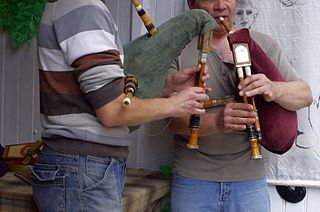Musette may refer to:
Musette may refer to:

Accordions are a family of box-shaped musical instruments of the bellows-driven free reed aerophone type. The essential characteristic of the accordion is to combine in one instrument a melody section, also called the diskant, usually on the right-hand keyboard, with an accompaniment or Basso continuo functionality on the left-hand. The musician normally plays the melody on buttons or keys on the right-hand side, and the accompaniment on bass or pre-set chord buttons on the left-hand side. A person who plays the accordion is called an accordionist.

Bagpipes are a woodwind instrument using enclosed reeds fed from a constant reservoir of air in the form of a bag. The Great Highland bagpipes are well known, but people have played bagpipes for centuries throughout large parts of Europe, Northern Africa, Western Asia, around the Persian Gulf and northern parts of South Asia.

The oboe is a type of double-reed woodwind instrument. Oboes are usually made of wood, but may also be made of synthetic materials, such as plastic, resin, or hybrid composites.

Woodwind instruments are a family of musical instruments within the greater category of wind instruments.
In France, music reflects a diverse array of styles. In the field of classical music, France has produced several prominent romantic composers, while folk and popular music have seen the rise of the chanson and cabaret style. The oldest playable musical recordings were made in France using the earlist known sound recording device in the world, the phonautograph, which was patented by Édouard-Léon Scott de Martinville in 1857. France is also the 5th largest market by value in the world, and its music industry has produced many internationally renowned artists, especially in the nouvelle chanson and electronic music.

The shawm is a conical bore, double-reed woodwind instrument made in Europe from the 12th century to the present day. It achieved its peak of popularity during the medieval and Renaissance periods, after which it was gradually eclipsed by the oboe family of descendant instruments in classical music. It is likely to have come to Western Europe from the Eastern Mediterranean around the time of the Crusades. Double-reed instruments similar to the shawm were long present in Southern Europe and the East, for instance the ancient Greek, and later Byzantine aulos, the closely related sorna and zurna, and the Armenian duduk.
Since the early 1970s, Brittany has experienced a tremendous revival of its folk music. Along with flourishing traditional forms such as the bombard-biniou pair and fest-noz ensembles incorporating other additional instruments, it has also branched out into numerous subgenres.
Bal-musette is a style of French instrumental music and dance that first became popular in Paris in the 1880s. Although it began with bagpipes as the main instrument, this instrument was eventually replaced by the accordion, on which a variety of waltzes, polkas, and other dance styles were played.
Auvergne is a region in France. Its best-known form of folk music is that played on the cabrette, a bagpipe made of goatskin. This is used to play swift, 3/8 dance music, slow airs (regrets) and other styles. The traditional master Joseph Rouls taught many modern players, including Dominique Paris, Jean Bona and Michel Esbelin. Other styles of music include the shepherd's calls known as ballero.

The piccolo oboe, also known as the piccoloboe or sopranino oboe and historically called an oboe musette, is the smallest and highest pitched member of the oboe family. Pitched in E♭ or F above the regular oboe, the piccolo oboe is a sopranino version of the oboe, comparable to the E♭ clarinet. It is most commonly found in early 20th-century marching band music, and more rarely in chamber music ensembles or contemporary compositions.

French bagpipes cover a wide range and variety of styles of bagpipes and piping, from the Celtic piping and Music of Brittany to the Northern Occitan's cabrette.

The pastoral pipe was a bellows-blown bagpipe, widely recognised as the forerunner and ancestor of the 19th-century union pipes, which became the uilleann pipes of today. Similar in design and construction, it had a foot joint in order to play a low leading note and plays a two octave chromatic scale. There is a tutor for the "Pastoral or New Bagpipe" by J. Geoghegan, published in London in 1745. It had been considered that Geoghegan had overstated the capabilities of the instrument, but a study on surviving instruments has shown that it did indeed have the range and chromatic possibilities which he claimed.

The musette de cour or baroque musette is a musical instrument of the bagpipe family. Visually, the musette is characterised by the short, cylindrical shuttle-drone and the two chalumeaux. Both the chanters and the drones have a cylindrical bore and use a double reed, giving a quiet tone similar to the oboe. The instrument is blown by a bellows.

Nicolas Chédeville was a French composer, musette player and musette maker.

The bombard is a contemporary family of oboes widely used to play traditional Breton music, where it is considered emblematic. A bombard player is known as a talabarder.
Italian music terminology consists of words and phrases used in the discussion of the music of Italy. Some Italian music terms are derived from the common Italian language. Others come from Spanish, or Neapolitan, Sicilian, Sardinian or other regional languages of Italy. The terms listed here describe a genre, song form, dance, instrument, style, quality of music, technique or other important aspect of Italian music.

The muchosa is a type of bagpipe dating back to the late 13th century in Hainaut, Belgium and northern France, where it is known as the pipasso.
Traditional French musical instruments, known as instruments traditionnels in French, are musical instruments used in the traditional folk music of France. They comprise a range of string, wind, and percussion instruments.